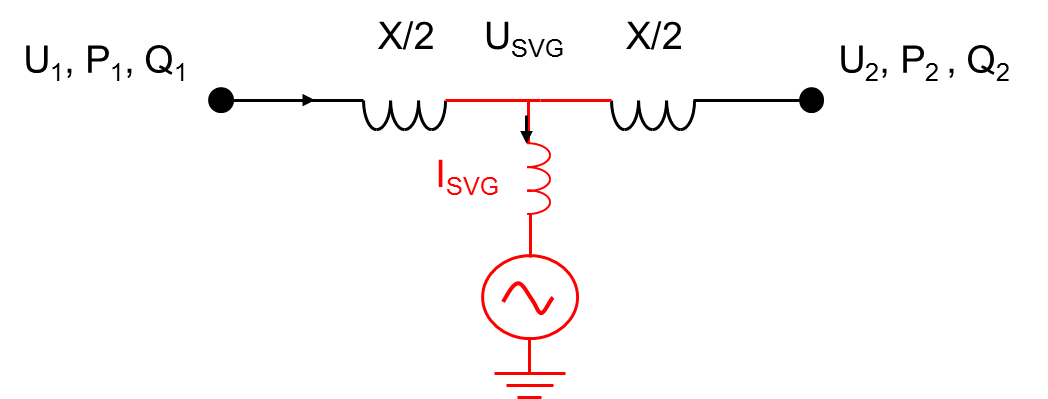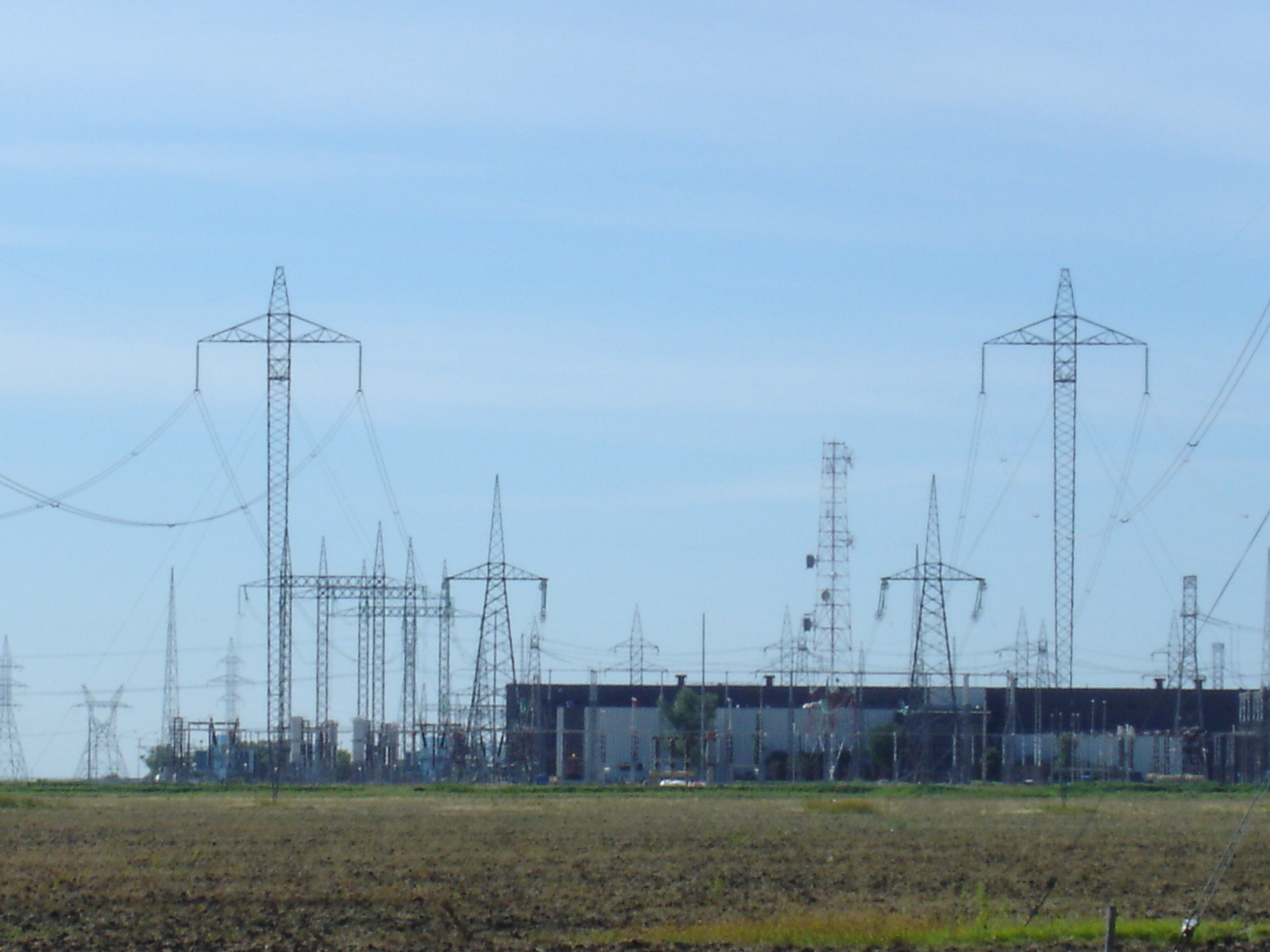|
Unified Power Flow Controller
A unified power flow controller (UPFC) is an electrical device for providing fast-acting reactive power compensation on high-voltage electricity transmission networks. It uses a pair of three-phase controllable bridges to produce current that is injected into a transmission line using a series transformer. The controller can control active and reactive power flows in a transmission line. Unified Power Flow Controller (UPFC), as a representative of the third generation of FACTS devices, is by far the most comprehensive FACTS device, in power system steady-state it can implement power flow regulation, reasonably controlling line active power and reactive power, improving the transmission capacity of power system, and in power system transient state it can realize fast-acting reactive power compensation, dynamically supporting the voltage at the access point and improving system voltage stability, moreover, it can improve the damping of the system and power angle stability. The UPF ... [...More Info...] [...Related Items...] OR: [Wikipedia] [Google] [Baidu] |
Electricity
Electricity is the set of physical phenomena associated with the presence and motion of matter that has a property of electric charge. Electricity is related to magnetism, both being part of the phenomenon of electromagnetism, as described by Maxwell's equations. Various common phenomena are related to electricity, including lightning, static electricity, electric heating, electric discharges and many others. The presence of an electric charge, which can be either positive or negative, produces an electric field. The movement of electric charges is an electric current and produces a magnetic field. When a charge is placed in a location with a non-zero electric field, a force will act on it. The magnitude of this force is given by Coulomb's law. If the charge moves, the electric field would be doing work on the electric charge. Thus we can speak of electric potential at a certain point in space, which is equal to the work done by an external agent in carrying a unit of p ... [...More Info...] [...Related Items...] OR: [Wikipedia] [Google] [Baidu] |
Reactive Power
Reactive may refer to: *Generally, capable of having a reaction (other) *An adjective abbreviation denoting a bowling ball coverstock made of reactive resin *Reactivity (chemistry) *Reactive mind *Reactive programming See also *Reactance (other) Reactance may refer to: * Electrical reactance In electrical circuits, reactance is the opposition presented to alternating current by inductance or capacitance. Greater reactance gives smaller current for the same applied voltage. Reactance is ... * Reactivity (other) {{disambig ... [...More Info...] [...Related Items...] OR: [Wikipedia] [Google] [Baidu] |
High-voltage
High voltage electricity refers to electrical potential large enough to cause injury or damage. In certain industries, ''high voltage'' refers to voltage above a certain threshold. Equipment and conductors that carry high voltage warrant special safety requirements and procedures. High voltage is used in electrical power distribution, in cathode ray tubes, to generate X-rays and particle beams, to produce electrical arcs, for ignition, in photomultiplier tubes, and in high-power amplifier vacuum tubes, as well as other industrial, military and scientific applications. Definition The numerical definition of depends on context. Two factors considered in classifying a voltage as high voltage are the possibility of causing a spark in air, and the danger of electric shock by contact or proximity. The International Electrotechnical Commission and its national counterparts (IET, IEEE, VDE, etc.) define ''high voltage'' as above 1000 V for alternating current, and at l ... [...More Info...] [...Related Items...] OR: [Wikipedia] [Google] [Baidu] |
Electric Power Transmission
Electric power transmission is the bulk movement of electrical energy from a generating site, such as a power plant, to an electrical substation. The interconnected lines that facilitate this movement form a ''transmission network''. This is distinct from the local wiring between high-voltage substations and customers, which is typically referred to as electric power distribution. The combined transmission and distribution network is part of electricity delivery, known as the electrical grid. Efficient long-distance transmission of electric power requires high voltages. This reduces the losses produced by strong currents. Transmission lines use either alternating current (HVAC) or direct current (HVDC). The voltage level is changed with transformers. The voltage is stepped up for transmission, then reduced for local distribution. A wide area synchronous grid, known as an "interconnection" in North America, directly connects generators delivering AC power with the same rela ... [...More Info...] [...Related Items...] OR: [Wikipedia] [Google] [Baidu] |
FACTS
A flexible alternating current transmission system (FACTS) is a system composed of static equipment used for the alternating current (AC) transmission of electrical energy. It is meant to enhance controllability and increase power transfer capability of the network. It is generally a power electronics-based system. FACTS is defined by the Institute of Electrical and Electronics Engineers (IEEE) as "a power electronic based system and other static equipment that provide control of one or more AC transmission system parameters to enhance controllability and increase power transfer capability". According to Siemens, "FACTS Increase the reliability of AC grids and reduce power delivery costs. They improve transmission quality and efficiency of power transmission by supplying inductive or reactive power to grid. Technology Shunt compensation In shunt compensation, power system is connected in shunt (parallel) with the FACTS. It works as a controllable current source. Shunt comp ... [...More Info...] [...Related Items...] OR: [Wikipedia] [Google] [Baidu] |
Thyristor
A thyristor () is a solid-state semiconductor device with four layers of alternating P- and N-type materials used for high-power applications. It acts exclusively as a bistable switch (or a latch), conducting when the gate receives a current trigger, and continuing to conduct until the voltage across the device is reversed biased, or until the voltage is removed (by some other means). There are two designs, differing in what triggers the conducting state. In a three-lead thyristor, a small current on its Gate lead controls the larger current of the Anode to Cathode path. In a two-lead thyristor, conduction begins when the potential difference between the Anode and Cathode themselves is sufficiently large (breakdown voltage). Some sources define silicon-controlled rectifier (SCR) and thyristor as synonymous. Other sources define thyristors as more complex devices that incorporate at least four layers of alternating N-type and P-type substrate. The first thyristor devices were ... [...More Info...] [...Related Items...] OR: [Wikipedia] [Google] [Baidu] |
STATCOM
A static synchronous compensator (STATCOM), originally known as a static synchronous condenser (STATCON), is a regulating device shunt-connected to alternating current electricity transmission network. It is based on a power electronics voltage-source converter and can act as either a source or sink of reactive AC power to an electricity network. If connected to a source of power it can also provide active AC power. It is a member of the FACTS family of devices, that became possible in 1990s due to availability of powerful gate turn-off thyristors (GTO). STATCOM is inherently modular and electable. These compensators can also be used to reduce voltage fluctuations. History and uses A prototype 1 MVAr STATCON was described in a report by Empire State Electric Energy Research Corporation in 1987. The first production 100 MVAr STATCON made by Westinghouse Electric was installed at the Tennessee Valley Authority Sullivan substation in 1995 and was quickly retired due to obsolesc ... [...More Info...] [...Related Items...] OR: [Wikipedia] [Google] [Baidu] |
Static Synchronous Series Compensator
A static synchronous series compensator (SSSC) is a type of flexible AC transmission system which consists of a solid-state voltage source inverter coupled with a transformer that is connected in series with a transmission line. This device can inject an almost sinusoidal voltage in series with the line. This injected voltage could be considered as an inductive or capacitive reactance, which is connected in series with the transmission line. This feature can provide controllable voltage compensation. In addition, SSSC is able to reverse the power flow by injecting a sufficiently large series reactive compensating voltage. See also * Active power filter * Static synchronous compensator (STATCOM), a similar shunt-connected device * Unified power flow controller A unified power flow controller (UPFC) is an electrical device for providing fast-acting reactive power compensation on high-voltage electricity transmission networks. It uses a pair of three-phase controllable bridges t ... [...More Info...] [...Related Items...] OR: [Wikipedia] [Google] [Baidu] |
Electrical Reactance
In electrical circuits, reactance is the opposition presented to alternating current by inductance or capacitance. Greater reactance gives smaller current for the same applied voltage. Reactance is similar to resistance in this respect, but does not lead to dissipation of electrical energy as heat; instead, energy is momentarily stored in the reactance, and a quarter-cycle later returned to the circuit. Reactance is used to compute amplitude and phase changes of sinusoidal alternating current going through a circuit element. Like resistance, reactance is measured in ohms, with positive values indicating ''inductive'' reactance and negative indicating ''capacitive'' reactance. It is denoted by the symbol X. An ideal resistor has zero reactance, whereas ideal inductors and capacitors have zero resistance. As frequency increases, inductive reactance increases and capacitive reactance decreases. Comparison to resistance Reactance is similar to resistance in that larger react ... [...More Info...] [...Related Items...] OR: [Wikipedia] [Google] [Baidu] |
Direct Current
Direct current (DC) is one-directional flow of electric charge. An electrochemical cell is a prime example of DC power. Direct current may flow through a conductor such as a wire, but can also flow through semiconductors, insulators, or even through a vacuum as in electron or ion beams. The electric current flows in a constant direction, distinguishing it from alternating current (AC). A term formerly used for this type of current was galvanic current. The abbreviations ''AC'' and ''DC'' are often used to mean simply ''alternating'' and ''direct'', as when they modify ''current'' or ''voltage''. Direct current may be converted from an alternating current supply by use of a rectifier, which contains electronic elements (usually) or electromechanical elements (historically) that allow current to flow only in one direction. Direct current may be converted into alternating current via an inverter. Direct current has many uses, from the charging of batteries to large power sup ... [...More Info...] [...Related Items...] OR: [Wikipedia] [Google] [Baidu] |
High-voltage Direct Current
A high-voltage direct current (HVDC) electric power transmission system (also called a power superhighway or an electrical superhighway) uses direct current (DC) for electric power transmission, in contrast with the more common alternating current (AC) transmission systems. Most HVDC links use voltages between 100 kV and 800 kV. However, a 1,100 kV link in China was completed in 2019 over a distance of with a power capacity of 12 GW. With this dimension, intercontinental connections become possible which could help to deal with the fluctuations of wind power and photovoltaics. HVDC allows power transmission between AC transmission systems that are not synchronized. Since the power flow through an HVDC link can be controlled independently of the phase angle between source and load, it can stabilize a network against disturbances due to rapid changes in power. HVDC also allows the transfer of power between grid systems running at different frequencies, such ... [...More Info...] [...Related Items...] OR: [Wikipedia] [Google] [Baidu] |





